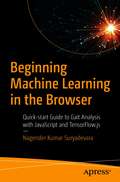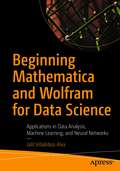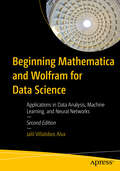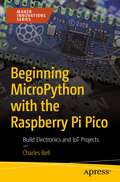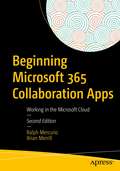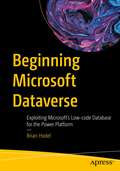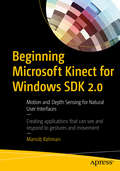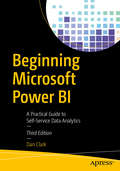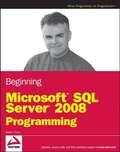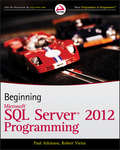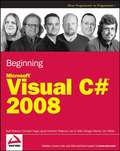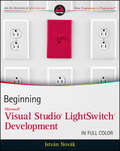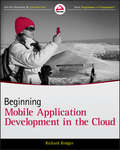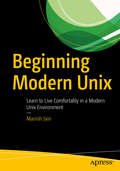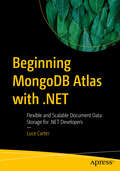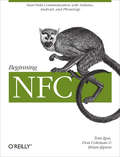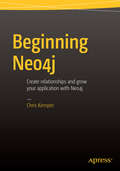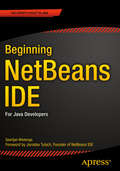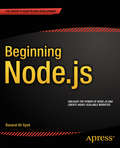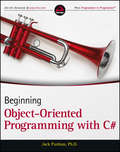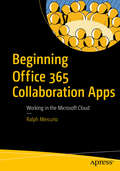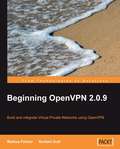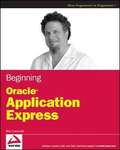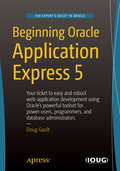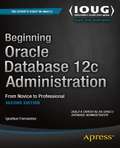- Table View
- List View
Beginning Machine Learning in the Browser: Quick-start Guide to Gait Analysis with JavaScript and TensorFlow.js
by Nagender Kumar SuryadevaraApply Artificial Intelligence techniques in the browser or on resource constrained computing devices. Machine learning (ML) can be an intimidating subject until you know the essentials and for what applications it works. This book takes advantage of the intricacies of the ML processes by using a simple, flexible and portable programming language such as JavaScript to work with more approachable, fundamental coding ideas. Using JavaScript programming features along with standard libraries, you'll first learn to design and develop interactive graphics applications. Then move further into neural systems and human pose estimation strategies. For training and deploying your ML models in the browser, TensorFlow.js libraries will be emphasized. After conquering the fundamentals, you'll dig into the wilderness of ML. Employ the ML and Processing (P5) libraries for Human Gait analysis. Building up Gait recognition with themes, you'll come to understand a variety of ML implementation issues. For example, you’ll learn about the classification of normal and abnormal Gait patterns. With Beginning Machine Learning in the Browser, you’ll be on your way to becoming an experienced Machine Learning developer. What You’ll LearnWork with ML models, calculations, and information gatheringImplement TensorFlow.js libraries for ML modelsPerform Human Gait Analysis using ML techniques in the browser Who This Book Is For Computer science students and research scholars, and novice programmers/web developers in the domain of Internet Technologies
Beginning Mathematica and Wolfram for Data Science: Applications in Data Analysis, Machine Learning, and Neural Networks
by Jalil Villalobos AlvaEnhance your data science programming and analysis with the Wolfram programming language and Mathematica, an applied mathematical tools suite. The book will introduce you to the Wolfram programming language and its syntax, as well as the structure of Mathematica and its advantages and disadvantages.You’ll see how to use the Wolfram language for data science from a theoretical and practical perspective. Learning this language makes your data science code better because it is very intuitive and comes with pre-existing functions that can provide a welcoming experience for those who use other programming languages. You’ll cover how to use Mathematica where data management and mathematical computations are needed. Along the way you’ll appreciate how Mathematica provides a complete integrated platform: it has a mixed syntax as a result of its symbolic and numerical calculations allowing it to carry out various processes without superfluous lines of code. You’ll learn to use its notebooks as a standard format, which also serves to create detailed reports of the processes carried out. What You Will Learn Use Mathematica to explore data and describe the concepts using Wolfram language commands Create datasets, work with data frames, and create tables Import, export, analyze, and visualize data Work with the Wolfram data repository Build reports on the analysis Use Mathematica for machine learning, with different algorithms, including linear, multiple, and logistic regression; decision trees; and data clustering Who This Book Is For Data scientists new to using Wolfram and Mathematica as a language/tool to program in. Programmers should have some prior programming experience, but can be new to the Wolfram language.
Beginning Mathematica and Wolfram for Data Science: Applications in Data Analysis, Machine Learning, and Neural Networks
by Jalil Villalobos AlvaEnhance your data science programming and analysis with the Wolfram programming language and Mathematica, an applied mathematical tools suite. This second edition introduces the latest LLM Wolfram capabilities, delves into the exploration of data types in Mathematica, covers key programming concepts, and includes code performance and debugging techniques for code optimization. You’ll gain a deeper understanding of data science from a theoretical and practical perspective using Mathematica and the Wolfram Language. Learning this language makes your data science code better because it is very intuitive and comes with pre-existing functions that can provide a welcoming experience for those who use other programming languages. Existing topics have been reorganized for better context and to accommodate the introduction of Notebook styles. The book also incorporates new functionalities in code versions 13 and 14 for imported and exported data. You’ll see how to use Mathematica, where data management and mathematical computations are needed. Along the way, you’ll appreciate how Mathematica provides an entirely integrated platform: its symbolic and numerical calculation result in a mized syntax, allowing it to carry out various processes without superfluous lines of code. You’ll learn to use its notebooks as a standard format, which also serves to create detailed reports of the processes carried out. What You Will Learn Create datasets, work with data frames, and create tables Import, export, analyze, and visualize data Work with the Wolfram data repository Build reports on the analysis Use Mathematica for machine learning, with different algorithms, including linear, multiple, and logistic regression; decision trees; and data clustering Who This Book Is For Data scientists who are new to using Wolfram and Mathematica as a programming language or tool. Programmers should have some prior programming experience, but can be new to the Wolfram language.
Beginning MicroPython with the Raspberry Pi Pico: Build Electronics and IoT Projects
by Charles BellProgram the Raspberry Pi Pico, the latest microcontroller board from raspberrypi.org, with MicroPython. This book will take you on a tour of the Raspberry Pi Pico, including how to get started using the microcontroller, seeing which alternative microcontrollers are available, and how to connect and run simple code examples. You’ll program example projects in MicroPython using Python on your PC as a learning platform. Then build your hardware skillset working with electronics and breadboard circuits. You'll implement example projects with all steps explained, including hardware connections and executing the project. Then apply them to real-world, approachable projects using the accessible Raspberry Pi Pico! The book shows how the cloud is used for IoT data and find out what popular cloud systems currently exist for IoT. Finally, you'll use ThingSpeak for hosting IoT data including connecting your Pico to the Internet. Beginning MicroPython with the Raspberry Pi Pico allows you to build up your skills to more advanced IoT projects and Cloud systems! What You Will LearnBuild valuable programming skills with MicroPython Explore the Raspberry Pi Pico and similar boardsDevelop your own electronics and IOT projectsIncorporate the Grove component system with the Raspberry Pi PicoWho This Book Is ForBeginners interested in learning to work with the Raspberry Pi Pico using MicroPython on microcontrollers with little to no experience in programming, hardware, or electronics. The book should also appeal to those who wanting to gain experience with building electronic solutions with microcontrollers.
Beginning Microsoft 365 Collaboration Apps: Working in the Microsoft Cloud
by Ralph Mercurio Brian MerrillStart making the most of the latest collaboration tools in Microsoft 365—including Teams, SharePoint, Power Apps, Power BI, Power Automate, Microsoft Groups, Office ProPlus, Yammer, Planner, Stream, Forms, and OneDrive. Integrate these collaboration tools into your team’s projects to boost productivity, engagement, innovation, and enjoyment at work. This book walks you through all the latest features, teaching you how to choose the right tools and get the most out of them for your situation.While technologies for collaboration are more advanced than ever before, there also are more of them, making it all the more confusing. Beginning Microsoft 365 Collaboration Apps will help you make sense of what is available and provide prescriptive guidance to you and your team on how to be more productive.This fully updated and expanded new edition contains lots of new content, screenshots and samples, and all new chapters on Power BI and Power Apps.What You Will LearnKnow the collaboration applications and features available across Microsoft 365, and how to choose the ones that are right for you and your colleagues in any given situationUnderstand the software-as-a-service (SaaS) model and how it enables users to be more effective and productive in remote situationsDiscover how multi-device usability and real-time cloud synchronization can help your team collaborate anytime, anywhere, across the appsFind out how Planner can help you manage projects and tasks, even without a project managerExplore Microsoft Power Automate and Power Apps to connect applications and services and create codeless applications and workflowsWho This Book is ForMicrosoft 365 business users with a limited technical background. You should be familiar with the Microsoft Office suite of products such as Word and Outlook, and work in a team environment. An active Microsoft 365 would be useful as well.
Beginning Microsoft Dataverse: Exploiting Microsoft’s Low-code Database for the Power Platform
by Brian HodelUnderstand the role that Dataverse plays in the low-code revolution that helps businesses gain advantage from being more agile with technology. This book shows you how to use Dataverse to solve business problems by describing the layers of a solution in the Power Platform and the options that exist at each layer so you can make informed decisions as you develop your solutions. The book shows how Dataverse is a central piece of the Microsoft Power Platform and helps tech-savvy professionals move nimbly and seize the day when opportunities present themselves. The book starts out by covering the platform in terms of its layers so you can orient yourself with the features that exist at each level and what that means to you as a developer. You will learn how to work inside the data layer to design tables to store data and relationships and manage how it all works together. You will learn how to apply business logic and validation in the business layer to ensure data integrity and enforce process compliance. You will learn how to design interfaces in the presentation layer to allow users to interact with your data and processes in user-friendly applications. And you will learn how to utilize third-party integration tools to create seamless connections between your solution and legacy systems so you can develop enterprise-grade tools in record time. What You Will LearnUnderstand the layers of Dataverse and the features at each layerCreate tables and relationships to store data and manage interactionsBuild applications to allow users to interact with your data using logical interfacesDesign business logic and workflows to ensure data integrity and automationConfigure security to control access to data and prevent unauthorized accessExplore the options for integration with third-party systems Who This Book Is ForMicrosoft Power Platform users who want to learn how to access the power of the Power Platform and leverage Dataverse to build powerful, robust, and resilient tools; power users and citizen developers who are looking for tools to quickly build scalable business solutions that don’t require a strong developer background; pro developers who want to learn how to utilize use the Power Platform to speed up the development cycle and deliver value to customers faster than ever before
Beginning Microsoft Kinect for Windows SDK 2.0: Motion and Depth Sensing for Natural User Interfaces
by Mansib RahmanDevelop applications in Microsoft Kinect 2 using gesture and speech recognition, scanning of objects in 3D, and body tracking. Create motion-sensing applications for entertainment and practical uses, including for commercial products and industrial applications. Beginning Microsoft Kinect for Windows SDK 2. 0 is dense with code and examples to ensure that you understand how to build Kinect applications that can be used in the real world. Techniques and ideas are presented to facilitate incorporation of the Kinect with other technologies. What You Will Learn Set up Kinect 2 and a workspace for Kinect application development Access audio, color, infrared, and skeletal data streams from Kinect Use gesture and speech recognition Perform computer vision manipulations on image data streams Develop Windows Store apps and Unity3D applications with Kinect 2 Take advantage of Kinect Fusion (3D object mapping technology) and Kinect Ripple (Kinect projector infotainment system) Who This Book Is For Developers who want to include the simple but powerful Kinect technology into their projects, including amateurs and hobbyists, and professional developers
Beginning Microsoft Power BI: A Practical Guide to Self-Service Data Analytics
by Dan ClarkAnalyze company data quickly and easily using Microsoft’s powerful data tools. Learn to build scalable and robust data models, clean and combine different data sources effectively, and create compelling and professional visuals. Beginning Power BI is a hands-on, activity-based guide that takes you through the process of analyzing your data using the tools that that encompass the core of Microsoft’s self-service BI offering. Starting with Power Query, you will learn how to get data from a variety of sources, and see just how easy it is to clean and shape the data prior to importing it into a data model. Using Power BI tabular and the Data Analysis Expressions (DAX), you will learn to create robust scalable data models which will serve as the foundation of your data analysis. From there you will enter the world of compelling interactive visualizations to analyze and gain insight into your data. You will wrap up your Power BI journey by learning how to package and share your reports and dashboards with your colleagues. Author Dan Clark takes you through each topic using step-by-step activities and plenty of screen shots to help familiarize you with the tools. This third edition covers the new and evolving features in the Power BI platform and new chapters on data flows and composite models. This book is your hands-on guide to quick, reliable, and valuable data insight. What You Will Learn Simplify data discovery, association, and cleansingBuild solid analytical data models Create robust interactive data presentations Combine analytical and geographic data in map-based visualizations Publish and share dashboards and reports Who This Book Is For Business analysts, database administrators, developers, and other professionals looking to better understand and communicate with data
Beginning Microsoft SQL Server 2008 Programming
by Robert VieiraThis comprehensive introduction to SQL Server begins with an overview of database design basics and the SQL query language along with an in-depth look at SQL Server itselfProgresses on to a clear explanation of how to implement fundamental concepts with the new 2008 version of SQL ServerDiscusses creating and changing tables, managing keys, writing scripts, working with stored procedures, programming with XML, using SQL Server Reporting and Integration Services, and moreFeatures updated and new material, including new examples using Microsoft's AdventureWorks sample database
Beginning Microsoft SQL Server 2012 Programming
by Robert Vieira Paul AtkinsonGet up to speed on the extensive changes to the newest release of Microsoft SQL ServerThe 2012 release of Microsoft SQL Server changes how you develop applications for SQL Server. With this comprehensive resource, SQL Server authority Robert Vieira presents the fundamentals of database design and SQL concepts, and then shows you how to apply these concepts using the updated SQL Server. Publishing time and date with the 2012 release, Beginning Microsoft SQL Server 2012 Programming begins with a quick overview of database design basics and the SQL query language and then quickly proceeds to show you how to implement the fundamental concepts of Microsoft SQL Server 2012.You'll explore the key additions and changes to this newest version, including conditional action constructs, enhanced controls for results paging, application integration with SharePoint and Excel, and development of BI applications.Covers new features such as SQL Azure for cloud computing, client-connectivity enhancements, security and compliance, data replication, and data warehouse performance improvements Addresses essential topics including managing keys, writing scripts, and working with store procedures Shares helpful techniques for creating and changing tables, programming with XML, and using SQL Server Reporting and Integration Services Beginning Microsoft SQL Server 2012 Programming demystifies even the most difficult challenges you may face with the new version of Microsoft SQL Server.
Beginning Microsoft Visual C# 2008
by Christian Nagel Karli Watson Morgan Skinner Jacob Hammer Pedersen Jon D. Reid Eric WhiteThe book is aimed at novice programmers who wish to learn programming with C# and the .NET framework. The book starts with absolute programming basics. It then moves into Web and Windows programming, data access (databases and XML), and more advanced technologies such as graphics programming with GDI+ and basic networking. The book is divided into sections including:The C# Language: Basic language skills using console application. Content moves from the absolute basics to fairly involved OOP skills.Windows Vista Programming: Using basic Windows applications, reinforcing earlier OOP and debugging skills.Web Programming: Putting together basic Web applications, highlighting differences between Web and Windows programming.Data Access: Accessing all kinds of data sources from Web and Windows applications, including SQL usage, XML, file system data, and Web Services.Additional Techniques: "The fun stuff", including Windows Presentation Foundation, Windows Workflow, Windows Communication Foundation, GDI+, networking, Windows Services, and so on.The book makes complicated subjects seem easy to learn, and it inspires readers to investigate areas further on their own by providing references to additional material, and exercise questions that require significant effort and personal research to complete.
Beginning Microsoft Visual Studio LightSwitch Development
by István NovákLearn how LightSwitch can accelerate and simplify application developmentAs Microsoft's newest offering for simplifying application development, LightSwitch opens the development door to creating applications without writing code. This introductory, full-color book shows you how to quickly create, modify, and distribute information for your business with LightSwitch. Packed with simple example programs, this beginner-level resource guides you through a complete small business application using LightSwitch to demonstrate the capabilities of this exciting new tool.You'll explore the most common application development issues that developers encounter on a daily basis and learn how LightSwitch makes them easier to handle with solutions that streamline application development without requiring code. Gets you started with Visual Studio LightSwitch, Microsoft's newest offering for simplifying application developmentShows you how to prepare a LightSwitch application and looks at the technologies behind a LightSwitch applicationAddresses working with simple data screens, working with master-detail data screens, and using exciting SQL server dataLooks at deploying applications, using SharePoint 2010 lists, and extending Visual Studio LightSwitchIf you're ready to simplify the application development process without writing a piece of code, then this is the book for you!
Beginning Mobile Application Development in the Cloud
by Richard RodgerLearn how to build apps for mobile devices on Cloud platforms The marketplace for apps is ever expanding, increasing the potential to make money. With this guide, you'll learn how to build cross-platform applications for mobile devices that are supported by the power of Cloud-based services such as Amazon Web Services. An introduction to Cloud-based applications explains how to use HTML5 to create cross-platform mobile apps and then use Cloud services to enhance those apps. You'll learn how to build your first app with HTML5 and set it up in the Cloud, while also discovering how to use jQuery to your advantage.Highlights the skills and knowledge you need to create successful apps for mobile devices with HTML5Takes you through the steps for building web applications for the iPhone and AndroidDetails how to enhance your app through faster launching, touch vs. click, storage capabilities, and a cacheLooks at how best to use JSON, FourSquare, jQuery, AJAX, and moreShares tips for creating hybrid apps that run nativelyIf you're interested in having your application be one of the 200,000+ apps featured in the iPhone store or the 50,000+ in the Android store, then you need this book.
Beginning Modern Unix: Learn to Live Comfortably in a Modern Unix Environment
by Manish JainDiscover how to leverage modern Unix even if you’ve never worked with Unix before. This book presents everything in conceptual terms that you can understand, rather than tips to be committed raw to memory. You will learn everyday tasks ranging from basic system administration—partitioning and mounting filesystems, software installation, network configuration, working from the command line) — to Bourne shell scripting, using graphical applications, as well as fanciful things such as emulation layers for Windows and Linux and virtualization with VirtualBox. It’s now 50 years since the creation of Unix but it is still growing. As Unix now moves to everyone's OS (open-source FreeBSD/Linux), it is the perfect time to start your journey with Beginning Modern Unix as your guide. What You'll Learn Live comfortably in a modern Unix environment, both on the command-line and in the graphical world. Choose the right hardware for UnixWork with Unix in real world settingsDevelop Unix applicationsReview advanced techniques in Shell scriptingWho This Book Is ForEveryone who uses a computer – those who intend to migrate to Unix as well as those who are worried about migrating to Unix, perhaps fearing it is a pure command-line or ‘difficult’ world.
Beginning MongoDB Atlas with .NET: Flexible and Scalable Document Data Storage for .NET Developers
by Luce CarterThis book is a tutorial on MongoDB customized for developers working in Microsoft .NET 6, .NET 7, and beyond. It explains the differences between relational database systems and the document model supported by MongoDB, and shows how to build .NET applications that run against a MongoDB database, especially one in the cloud. Author Luce Carter kicks things off by teaching you how to determine when to use a document database versus a relational engine. After that, she walks you through building a Microsoft .NET project combining the MongoDB Atlas cloud database as a service solution with a .NET. application. In the process, you will learn how to create, read, update, and delete data in MongoDB from any .NET project. You will come away from this book with a solid understanding of MongoDB’s Developer Data Platform and how to use it from your .NET applications. You’ll be able to connect to MongoDB in the cloud and take advantage of the flexibility and scalability that MongoDB’s document storage model provides, and you’ll understand how to craft your applications to run using document storage and the MongoDB database engine. What You Will Learn Know when to use the MongoDB document model Build .NET applications that connect to MongoDB for data storage Create MongoDB clusters on the MongoDB Atlas cloud platform Store data in MongoDB Atlas Create, Read, Update, and Delete (CRUD) data from .NET Web API projects Test your CRUD endpoints using RESTful operations Validate schemas to help protect against breaking changes Who This Book Is For .NET developers who are looking for an alternative to relational databases, and those looking for a flexible and scalable document storage solution for use from .NET applications. Additionally, anyone wanting to learn MongoDB in the context of .NET and C# will benefit from this book.
Beginning NFC: Near Field Communication with Arduino, Android, and PhoneGap
by Brian Jepson Tom Igoe Don ColemanJump into the world of Near Field Communications (NFC), the fast-growing technology that lets devices in close proximity exchange data, using radio signals. With lots of examples, sample code, exercises, and step-by-step projects, this hands-on guide shows you how to build NFC applications for Android, the Arduino microcontroller, and embedded Linux devices.You’ll learn how to write apps using the NFC Data Exchange Format (NDEF) in PhoneGap, Arduino, and node.js that help devices read messages from passive NFC tags and exchange data with other NFC-enabled devices. If you know HTML and JavaScript, you’re ready to start with NFC.Dig into NFC’s architecture, and learn how it’s related to RFIDWrite sample apps for Android with PhoneGap and its NFC pluginDive into NDEF: examine existing tag-writer apps and build your ownListen for and filter NDEF messages, using PhoneGap event listenersBuild a full Android app to control lights and music in your homeCreate a hotel registration app with Arduino, from check-in to door lockWrite peer-to-peer NFC messages between two Android devicesExplore embedded Linux applications, using examples on Raspberry Pi and BeagleBone
Beginning Neo4j
by Chris KemperThis book is your introduction in the world of graph databases, and the benefits they can bring to your applications. Neo4j is the most established graph database on the market, and it's always improving to bring more of its benefits to you. Beginning Neo4j will take you from the installation of Neo4j through to building a full application with Neo4j at its heart, and everything in between. Using this book, you'll get everything up and running, and then learn how to use Neo4j to build up recommendations, relationships, and calculate the shortest route between two locations. With example data models, and an application putting everything together, this book will give you everything you need to really get started with Neo4j. Neo4j is being used by social media and ecommerce industry giants. You can take advantage of Neo4j's powerful features and benefits - add Beginning Neo4j to your library today. What you'll learn Learn what Neo4j is and methods on how to install it Using Cypher, Neo4js query language to retrieve data Example data structures to help shape your application How to create relationships and recommendations between data Create an application that uses PHP and Neo4j together Taking your new Neo4j application into production Use Neo4j to calculate the shortest path between two locations Who this book is for This book is for anyone who wants to get started with graph databases, and doesn't know where to start. Table of Contents Chapter One: Introduction to Graph Databases Chapter Two: Getting to Know Neo4j Chapter Three: Get Up and Running with Neo4j Chapter Four: Meet Cypher Chapter Five: Managing Your Data in Neo4j Chapter Six: Importing and Exporting Data Chapter Seven: Using Data in Neo4j Chapter Eight: Building an App in Neo4j Chapter Nine: Neo4j in Production
Beginning NetBeans IDE: For Java Developers
by Geertjan WielengaBeginning NetBeans IDE is your authoritative guide for getting started learning and using the free and open source NetBeans IDE. Written by Geertjan Wielenga, who has worked on the NetBeans Team since 2004, it shows you what the IDE is all about and how to use it with real-world case studies built from the ground up as you learn all about the IDE. In this book, you get a tour of the various, essential, and key NetBeans features, including a range of wizards and plug-ins. Then, you start building a more complex Java EE-based application using Maven with the NetBeans IDE. And, you learn how to improve that application by exploring the NetBeans refactoring, testing, debugging, and profiling tools. After reading and using this guide, you'll come away with a working case study and many insights into how to understand and optimally make use of NetBeans IDE. What you'll learn What is NetBeans and how to use it How to install and set up your NetBeans IDE and environment How to write your first Java application using NetBeans How to explore the key NetBeans wizards and plug-ins How to build a complex Java EE-based application using Maven with NetBeans How to improve applications by refactoring, testing, debugging, and profiling Who this book is for This book is for those who are new to NetBeans who may have prior Java coding experience. Table of Contents 1. Installing and Setting Up 2. Getting Started 3. Java Editor 4. Using Wizards and Plugins 5. Putting the Pieces Together 6. Analysis and Refactoring 7. Testing and Code Quality 8. Debugging 9. Profiling and Tuning 10. Versioning
Beginning Node.js
by Basarat Ali SyedBeginning Node. js is your step-by-step guide to learning all the aspects of creating maintainable Node. js applications. You will see how Node. js is focused on creating high-performing, highly-scalable websites, and how easy it is to get started. Many front-end devs regularly work with HTML, CSS, PHP, even WordPress, but haven't yet got started with Node. js. This book explains everything for you from a beginner level, enabling you to start using Node. js in your projects right away. Using this book you will learn important Node. js concepts for server-side programming. You will begin with an easy-to-follow pure JavaScript primer, which you can skip if you're confident of your JS skills. You'll then delve into Node. js concepts such as streams and events, and the technology involved in building full-stack Node. js applications. You'll also learn how to test your Node. js code, and deploy your Node. js applications on the internet. Node. js is a great and simple platform to work with. It is lightweight, easy to deploy and manage. You will see how using Node. js can be a fun and rewarding experience - start today with Beginning Node. js. What you'll learn * Learn how JavaScript can help you be highly productive as a full-stack developer * How to set up an end to end Node. js development environment * Learn how to create reusable and maintainable Node. js modules * Patterns for sharing code between the server and the client * Create Node. js restful web services and websites * Store and retrieve your data using Document Databases * How to test your Node. js applications * How to deploy your applications on the internet Who this book is for Beginning Node. js is great for front-end developers looking to use Node. js in their websites. If you understand the basics of programming this book will teach you how you can leverage JavaScript to create full stack web-apps using Node. js. Node. js allows you to write code that runs both on the client and server. This allows you to reuse more code and deliver applications faster. From this book you will learn how to write maintainable server-side JavaScript using Node. js, how to test your code and deploy it on the internet. Table of Contents Chapter 1: Setting up for Node. js Development Chapter 2: Understanding Node. js Chapter 3: Core Node. js Chapter 4: Node. js Packages Chapter 5: Events and Streams Chapter 6: Getting Started with HTTP Chapter 7: Introducing Express Chapter 8: Persisting Data Chapter 9: Front-End Basics Chapter 10: Simplifying Callbacks Chapter 11: Debugging Chapter 12: Testing Chapter 13: Deployment and Scalability
Beginning Object-Oriented Programming with C#
by Jack PurdumThe ideal beginner's guide to C# and object-oriented programmingWrox beginners' guides have the perfect formula for getting programming newcomers up and running. This one introduces beginners to object-oriented programming using C# to demonstrate all of the core constructs of this programming framework. Using real-world situations, you'll discover how to create, test, and deliver your programs and how to work with classes, arrays, collections, and all the elements of object-oriented programming.Covers exactly what beginners, even those with no prior programming experience, need to know to understand object-oriented programming and start writing programs in C# Explains the advantages and disadvantages of C#, and tips for understanding C# syntax Explores properties, encapsulation, and classes; value data types; operands and operators; errors and debugging; variables; and reference types Shows how to use statement repetition and program loops, understand arrays and collections, and write your own classes Also covers inheritance and polymorphismBeginning Object-Oriented Programming with C# uses the tried-and-true Wrox formula for making this popular programming method easy to learn.
Beginning Office 365 Collaboration Apps: Working in the Microsoft Cloud
by Ralph MercurioStart making the most of the latest collaboration tools in Office 365—including SharePoint, OneDrive, Office 365 Groups, Office, Teams, Yammer, Planner, Stream, Forms, and Flow—and integrate them into your team’s projects to boost productivity, engagement, innovation, and enjoyment at work. This book walks you through the features, teaching you how to choose the right tools for your situation.While technologies for collaboration are more advanced than ever before, there also are more of them. Beginning Office 365 Collaboration Apps will help you make sense of what is available and how it can help you and your team be more productive.What You'll LearnKnow the collaboration features available across Office 365, and how to choose the ones that are right for you and your colleagues in any given situationUnderstand the software-as-a-service (SaaS) model and how it enables users to be more productive and effectiveDiscover how multi-device usability and real-time cloud synchronization can help your team collaborate any time, anywhere, across the appsFind out how Planner can help you manage projects and tasks, even without a project managerExplore Microsoft Flow to connect applications and services and create code-less workflowsWho This Book is ForOffice 365 business users with a limited technical background. You should be familiar with the Microsoft Office suite products such as Word and Outlook, and work in a team environment.
Beginning OpenVPN 2.0.9
by Markus Feilner Norbert GrafThis book is an easy introduction to OpenVPN. While providing only necessary theoretical background, it takes a practical approach, presenting plenty of examples. It is written in a friendly style making this complex topic easy and a joy to read. It first covers basic VPN concepts, then moves to introduce basic OpenVPN configurations, before covering advanced uses of OpenVPN. This book is for both experienced and new OpenVPN users. If you are interested in security and privacy in the internet, or want to have your notebook or mobile phone connected safely to the internet, the server in your company, or at home, you will find this book useful. It presumes basic knowledge of Linux, but no knowledge of VPNs is required.
Beginning Oracle Application Express
by Rick GreenwaldThis book shows you how to master Application Express to build effective web-based Oracle database applications. The author provides hands-on, step-by-step guidance on the complete development process, through creating, customizing, and extending the application. In addition to presenting how to build a simple application, this guide also details reporting and charting, themes and templates, and security. Additionally, it demonstrates how to use packaged applications and how to work with multiple applications. Data migration and integration with the Oracle environment is also discussed.
Beginning Oracle Application Express 5
by Doug GaultWhether you're new to Oracle or an old hand who's yet to test the waters of APEX, Beginning Oracle Application Express 5 introduces the processes and best practices you'll need to become proficient with APEX. The book shows off the programming environment, the utilities and tools available, and then continues by walking through the process of building a working system from the ground up. All code is documented and explained so that those new to the languages will not be lost. After reading this book, power users and programmers alike can quickly put together robust and scalable applications for use by one person, by a department, by an entire company. Beginning Oracle Application Express 5 introduces version 5 of the popular and productive Oracle Application Express development platform. Called APEX for short, the platform enables rapid and easy development of web-based applications that make full use of Oracle Database. The release of APEX 5 brings major new changes to the page builder, an enhanced universal theme, better RESTful web services support, enhanced application packaging, and the many redesigned wizards give a new and fresh feel to the user interface. Covers brand-new functionality in APEX 5 Provides fully documented and explained example code Guides you through creating a working and fully deployable application What you'll learn Design, code, and troubleshoot APEX applications Create forms and reports, and generate charts using Flash and HTML 5 Take advantage of improved, RESTful web services support Create intuitive navigation that inspires confidence among users Secure your applications from outside attack Deploy applications for one, a dozen, or hundreds of users Choose between desktop and mobile user interfaces for deployed applications Who this book is for Beginning Oracle Application Express 5 is for programmers and power users wanting to create rich, data-centric applications that are web-based, and that rest on Oracle's industry-leading database technology. Table of Contents 1. An Introduction to APEX 2. A Developer's Overview 3. Identifying the Problem and Designing the Solution 4. SQL Workshop 5. Application and Navigational Components 6. Forms & Reports--The Basics 7. Forms & Reports--Advanced 8. Programmatic Elements 9. Security 10. Application Deployment 11. Understanding Websheets 12. A WebSheets Example 13. Extended Developer Tools 14. Managing Workspaces 15. Team Development 16. Dynamic Actions 17. Appendix A
Beginning Oracle Database 12c Administration: From Novice to Professional
by Ignatius FernandezBeginning Oracle Database 12c Administration is your entry point into a successful and satisfying career as an Oracle Database Administrator. The chapters of this book are logically organized into four parts closely tracking the way your database administration career will naturally evolve. Part 1 "Database Concepts" gives necessary background in relational database theory and Oracle Database concepts, Part 2 "Database Implementation" teaches how to implement an Oracle database correctly, Part 3 "Database Support" exposes you to the daily routine of a database administrator, and Part 4 "Database Tuning" introduces the fine art of performance tuning. Beginning Oracle Database 12c Administration provides information that you won't find in other books on Oracle Database. You'll discover not only technical information, but also guidance on work practices that are as vital to your success as are your technical skills. The author's favorite chapter is "The Big Picture and the Ten Deliverables. " (It is the editor's favorite chapter too!) If you take the lessons in that chapter to heart, you can quickly become a much better Oracle database administrator than you ever thought possible. You will grasp the key aspects of theory behind relational database management systems and learn how to: * Install and configure an Oracle database, and ensure that it's properly licensed; * Execute common management tasks in a Linux environment; * Defend against data loss by implementing sound backup and recovery practices; and * Improve database and query performance. What you'll learn Execute common management tasks in a Linux environment. Take advantage of pluggable database features for cloud and consolidation. Install and configure an Oracle database, and see that it's properly licensed. Defend against data loss by implementing sound backup and recovery practices. Properly size a database, and create indexes to improve its query performance. Grasp the key aspects of theory behind relational database management systems. Who this book is for Beginning Oracle Database 12c Administration is the perfect book for those wanting to jumpstart a career in database administration. If you're making the move into that role, or if the role has been thrust upon you by circumstances, you can hardly do better than to have author Iggy Fernandez at your side as you learn the ropes and lay down the foundation of your future success. Table of Contents Part I: Database Concepts 1. Relational Database Management Systems 2. SQL and PL/SQL 3. Oracle Architecture Part II: Database Implementation 4. Planning 5. Software Installation 6. Database Creation 7. Physical Database Design 8. User Management and Data Loading Part III: Database Support 9. Taking Control 10. Monitoring 11. Fixing Problems 12. Backups 13. Recovery 14. Database Maintenance 15. The Big Picture and the Ten Deliverables Part IV: Database Tuning 16. Instance Tuning 17. SQL Tuning
